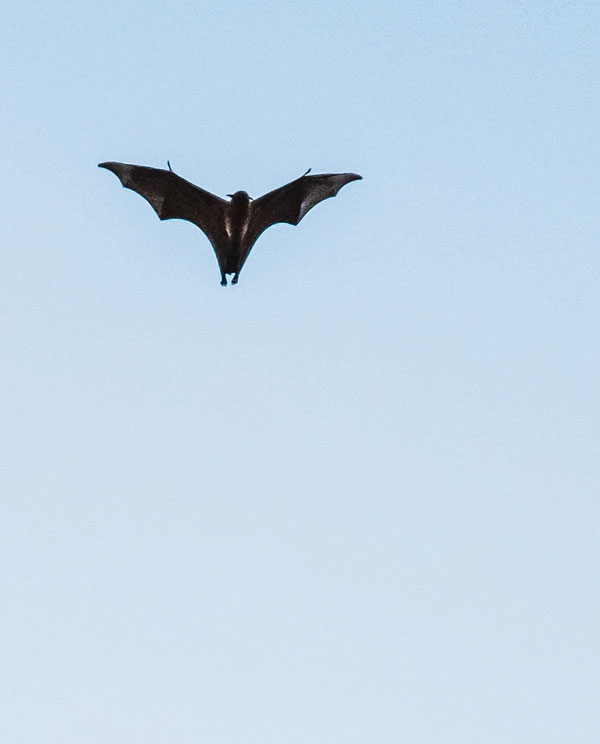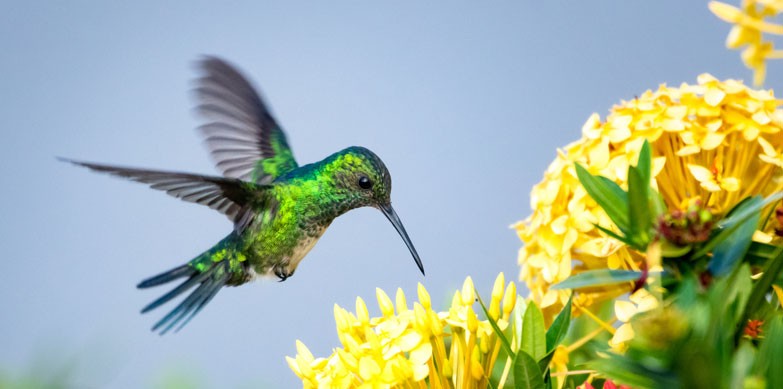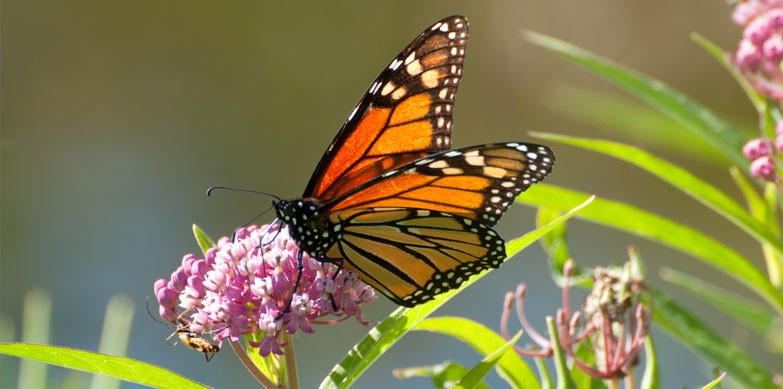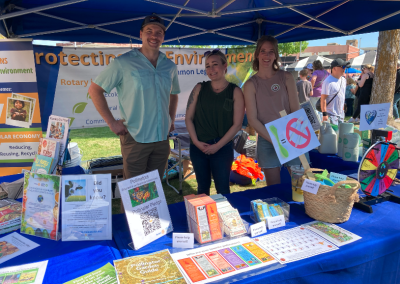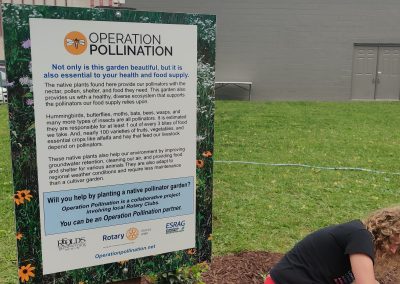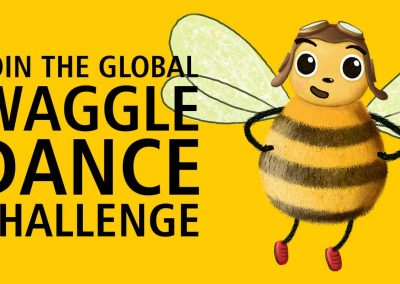TASKFORCE
Pollinators
Protect pollinators. They are essential to our food web, ensure biodiversity
and provide irreplaceable ecosystem services.
WHAT IS IT?
Pollinator Protection
The ESRAG Pollinator Task Force educates and supports action
on four simple ways to protect pollinators:
Grow pollinator friendly flowers, provide nest sites,
avoid pesticides, and spread the word.
POLLINATORS
Featured Projects
Projects the task force supports.
Operation Pollination
Join the growing “Movement” of Rotarians who take action to protect pollinators and educate their communities.
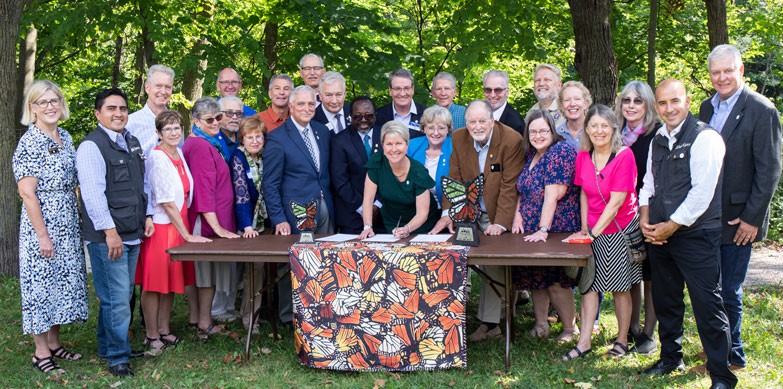
RI President Jennifer Jones signs an Operation Pollination Partnership as well as fourteen Rotary leaders from the greater Chicago Region, southeast Wisconsin, and southwest Michigan. These leaders will now encourage their District’s Club Presidents to sign a Pollinator Pledge.
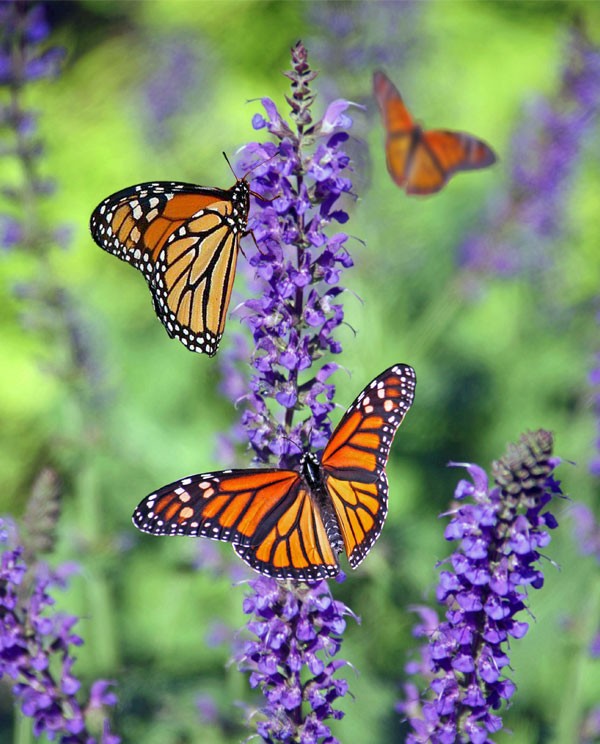
PROTECT POLLINATORS
Project Objectives
OUR GOAL: To increase awareness about the importance of
pollinators to food security, biodiversity and climate solutions.
Where to begin?
Many important food plants and trees do not self or wind-pollinate. Bees, butterflies, other insects, birds bats, etc. all provide essential ecosystem services of spreading pollen to ensure fertilization, fruiting and seed formation of a large number of plants. Human actions including fragmenting habitat, monocropping, excessive pesticide use, and increasing climate disruptions all threaten pollinator populations around the globe. Humans can reverse the losses and support pollinators by growing pollinator friendly plants, providing nest sites, avoiding pesticides, and spreading the word.
Check out these project ideas and resources. In each category, suggestions are arranged from simplest to most challenging.
Currently many of the suggestions for personal actions and club projects are linked to North American centric resources.
Here are a list of general resources:
- Monarch Joint Venture – Partnering to conserve the monarch butterfly migration
- Xerces Society – for Invertebrate Conservation
- Pollinator Partnership – Protect their lives. Preserve ours.
We welcome resource suggestions from around the world, so that our content is more global. Contact us today.
Promote and Publicize
Support ‘No Mow May’
Early spring before many of the plants have flowered is a critical time for wild pollinators. plants in your lawn are an important early food source.Allowing the plants in your lawn to bloom before the first mowing, nourishes pollinators in the spring. Working with Homeowners’ associations and local authorities create a ‘No mow May’ campaign. Use those spring hours not spent mowing to support pollinators in other ways.
Put up a sign
Pollinator organizations offer printed signs to inform that the area isn’t being mowed or sprayed because it’s supporting pollinators. What a great way to help your neighbors think about the needs and importance of pollinators.
Register your pollinator garden
Pollinator.org supports a nationwide campaign to register pollinator garden to keep track of the growing network of micro habitats being created to support pollinator communities. Registering gardens identifies gaps so we can focus on linking them.
Get local media coverage
As you gather community leaders or create a project, enroll the local media to help you with your outreach and reporting. Modify this media release template to suit the needs of your club.
Enhance outreach materials
Part of implementing your project may include writing a blog post, designing a brochure or adding content to your club’s website to support your community coalition. Many of the listed pollinator webpages offer have content on which you can build.
Record project details and progress with iRotree
Being sustainable includes recording info about your project: a baseline, project details and your future progress. Esrag‘s iRotree app will help you do that. Download the iRotree app on your App Store and connect with information on irotree.org. The developersare happy to train you on how to use the device. It’s a great way tto ensure that your projects are impactful, measurable and sustainable.
Community Education
Distribute seed packs at community events
Distribute packets of appropriate pollinator native seed mixes, with your club’s info, at farmers markets or other community gatherings. A great way to encourage people to plant their own mini pollinator gardens.
Join a pollinator organization
You are not in this alone! There are many national and international organizations with lots of resources to support your efforts. Xerces, Million Pollinator Gardens and ChangeX are a few to get you started.
Find local partners
Contact your local park service, department of public works, cooperative botanical garden or arboretum. Local conservation groups, watershed alliances and local chapters of Audubon and the Sierra club can provide you with willing partners. Rotary volunteers’ expertise and enthusiasm are always welcome.
Present community programs
Starting with your own Rotary club invite local experts from universities and cooperative extension to explain to your club why this is important. Through those partnerships use your pollinators projects to share Rotary‘s interest on this topic, and build your club’s membership.
Enroll as Bee City USA
Following their guidelines you can create a committee locally to advocate for pollinators, create and enhance pollinator habitat on public and private lands, reduce the use of pesticides, incorporate pollinator- conscious practices in the city policies and plans, host pollinator awareness events and post signage announcing what you’re doing. Fees depend on the size of city. Or look for a similar organization in your local area.
Citizen science projects
Xerxes Society lists a number of citizen science projects to count and map monarch migrations, and help create bumblebee atlases in various states and more. Insight Citizen Science offers an app and resources for Canadians.
Host a Pollinator Movie Night
Here are some films worth promoting for a community watch. Pass the popcorn and raise a little money for pollinators.
Host a Community Action Summit
Rotarians organize great events, or team up with a local university or a conservation group chapter that needs a support and funding.
Fund a pollinator bench or art installation
School Programs
Seed distribution to students
Add pollinator appropriate native seed packets with your club’s info to back-to- school backpacks, which your club sponsors, or as a part of supporting education about pollinators.
Fund educational materials
Many science-based pollinator organizations offer ready to go curriculum programs, for a fee. Donate to support buying those educational materials.
Present school programs
If you have expertise in the field, work with your schools science teachers to present a community program to help get them inspired.
Sponsor a Monarch Sister School
Monarch Sister Schools engage students in habitat restoration with hands-on learning and cultural exchanges between sister schools in the US and Mexico in the butterfly reserve in Mexico. For as little as US $250 your club can support a program tailored to meet you or local school’s needs.
School based Monarch Waystation
Habitat loss endangers the magnificent monarch migration, which covers thousands of miles from Canada to Mexico. Planting Monarch Waystation gardens ensures that the monarchs will find the right plants to support their journey.
School pollinator garden
Help your community school plant and maintain a pollinator garden as an outdoor teaching lab to inspire future generations.
Citizen science project
Make science come alive by supporting the citizens science projects within your schools.
Plant for Pollinators
Collect Pollinator plant seeds, for scattering and starting seedlings
Offer a community service project of gathering seeds from restored prairies and existing pollinator gardens. Those seeds can be planted where needed and used to start next year‘s plugs for transplanting.
Support others’ projects
Get ready for a larger commitment to pollinators by volunteering to maintain existing pollinator gardens and Monarch Waystations.
Organize a fundraiser to support pollinator projects and organizations
Planting and maintaining pollinator gardens require funding. Organize a community fundraiser possibly by selling pollinator plants to get your own garden started or enlarged.
Grow pollinator plants on rooftops and roadside
Even if you don’t have a backyard, you can grow pollinator plants in a pot on your apartment balcony or adopt a stretch of road side that is currently a pollinator wasteland.
Plant native milkweed
Milkweeds are tricky to start from seed but nurseries sell milkweed plant plugs. The same nurseries may welcome the seeds you’ve collected.
Landscape with native plants
Ensure that native plants that best support the local ecosystem are planted in your backyard or places where you can influence plant selection.
Make your backyard pollinator friendly
Choose native plants, eliminate competing invasive species, avoid pesticides and minimize overnight lighting
Community pollinator garden
Using public or private land and working with local government create and maintain a community pollinator garden. Regional planting guides will show you how.
Plan and plant a larger scale pollinator habitat
Organize a coalition to take on a multiple acre pollinator restoration project.
Project Ideas
Sign a pollinator resolution
Working with the operation pollination team, gather club district and community leaders to sign a non-binding resolution to get started protecting pollinators.
Sign a pollinator pledge
Within your club commit to take action to protect pollinators. The list of Project inspirations will help you get started.
Provide nesting places for bees
Provide places for solitary wild bees to build their nests. Wild bees, not the honeybees and their hives, provide up to 30% of the pollination services in some areas.
Use pollinator-friendly (pf) pest control
Many pollinators insects are susceptible to pesticides, including neonicotinoids which are absorbed by plants and can be present in pollen and nectar, making them toxic to pollinators. Minimize use of pesticides in your own yards and work with those maintaining public lands to do the same. Support integrated pest management (IPM) strategies that reduce pesticide use where possible.
Reduce light pollution to protect pollinators
Artificial lighting at night confuses many pollinators, reducing their ability to breed and effectively pollinate. Turning off unnecessary lighting supports their vital ecosystem services.
Want to take action by Protecting Pollinators?
There are four simple ways to protect pollinators:
-
Grow pollinator friendly flowers
-
Provide nest sites
-
Avoid pesticides
-
Spread the word
